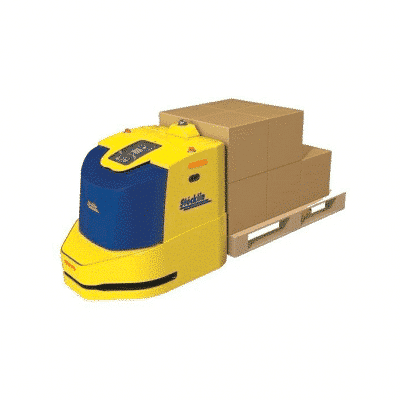Logistics has seen some tremendous improvements over the last decade as trade has become global. With digitization and smart technologies, businesses can now improve their processes and offer their customers faster deliveries. Speed is the big driver of the century with customers wanting their products delivered the same day.
Thanks to robotics, computing power, artificial intelligence, data analytics and digital twins it is possible to optimize equipment like never before. When we attended Automation Fair in Chicago last November, we picked 3 technologies that can help businesses continue to disrupt in this ongoing competitive environment.
Robot Packer Simulation

“Time is money”. This saying has never been as appropriate as it is for logistics. The prime objective for the sector is speed. The goal is to pack quickly, label quickly, transport quickly and deliver quickly. What if you could simulate some of these tasks digitally before implementing them in the real world in order to save time and money? This is what Rockwell Automation has been working on regarding robotic packers. They partnered with robot manufacturer Fanuc and digital twin technology provider Emulate3D to design a solution that can simulate the position and sequence of a robot packer in the digital world. This solution combines Fanuc’s robot guide, an engineering tool that teaches a robot the moves it has to make, and Emulate3D’s digital twin software.
John Pritchard, global portfolio at Rockwell, explained:
“You can put a robot into a realistic manufacturing environment and it can interact, pick up boxes, place them among conveyors. There are sensors on the boxes that can trigger logical events which you control with one of our controllers. So you can go from understanding what just a single robot is going to do to how robots are going to behave in real manufacturing environments. We are making all these insights in the digital world, rather than getting on site, in a real manufacturing facility, and making mistakes which costs more and takes longer.”
AR and the Hybrid Conveyor System
Rockwell Automation’s MagneMotion is a transport system that is specifically designed to move light loads such as cans very quickly and efficiently. It uses magnets and linear motors and takes a more flexible approach to logistics.
They combined their magnetic system with a more traditional conveyor system made by FlexLink to offer a hybrid conveyor system.

This hybrid system combines the advantages of the magnet system which offers more flexibility as the conveyor can stop in case there is a problem and start back up quite easily. The FlexLink system can move products long distances and also on elevation chains. The objective is to offer logistics businesses the ability to adapt to different conditions or unexpected situations without cutting back on process optimization and throughput.
“When a can is missing from a carriage, sensors will notice that. The tray will move from the MagneMotion system to the FlexLink system and sensors will send the information to our controllers and then to Vuforia, a PTC AR technology. Vuforia will generate a dynamic work instruction. The operator will just have to do the rework, replace the missing can, and the carriage will go off the FlexLink and back into the MagneMotion system”.
AGVs and Modulable Warehouses

How to Choose an AGV?
Read our buying guide and make the smart choice.
Cheaper logistics solutions are what companies could be looking at to optimize their processes at a low cost. We met with Fulvio Calvo, Sales manager at Olivero, an Italian company that offers industrial plant design, construction, assembly and maintenance service. He showed us an AGV, the kind that’s used in warehouses to convey goods. It is equipped with software and a scanner that map its environment and allow it to move safely. But this AGV is more than a simple autonomous vehicle. When combined with other AGVs, it can become a real mobile conveyor and replace traditional industrial conveyors. And this has a great advantage, explains Calvo:
“You can connect different AGVs together to have a fleet that can navigate in the factory and convey goods. We have software that can handle this. If you want to move products in a plant at a low-cost, this is the right logistics solution. This solution allows you to module your plant according to your needs. Maybe today you want your fleet to weave from A to B and tomorrow you want it to go from B to C in a strait way. This is more flexible.”
Flexibility is one of industry 4.0’s major promises. This system offers the ability to deploy your lines where you need them and allows you to module your factory depending on the volume you have to handle.
According to experts, the industry is expected to reach nearly $13 billion by 2022. Innovation and digital disruption will remain fundamental to the strategy of businesses.











